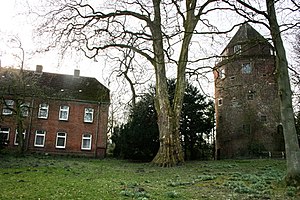Stickhausen Castle
| Stickhausen Castle | |
|---|---|
| Burg Stickhausen | |
| Detern-Stickhausen | |

Stickhausen Castle
|
|
| Coordinates | 53°13′05″N 7°38′36″E / 53.218012°N 7.643212°E |
| Type | Concentric castle |
| Site information | |
| Open to the public |
yes |
| Site history | |
| Built | c. 1345 |
Stickhausen Castle is located on the western edge of the village Stickhausen, a district of the East Frisian municipality Detern in the Landkreis of Leer in Lower Saxony.
The castle is situated on the banks of the Jümme. This river, together with the nearby Leda forms the so-called East Frisian Mesopotamia, the Leda-Jümme area. Both rivers were important trade routes in the Middle Ages and early modern times, because they flowed in an east-west direction.
The name of the castle as well as the village is composed of the words Sticke (stick, pole) and Hause (house) and means a house fortified with palisades.
Unlike the other castles of East Friesia, Stickhausen Castle was never the seat of the East Frisian chieftains. It was built around 1345 by the city of Hamburg to protect their west-bound trade routes. After intense debate, the Hamburg pledged them in about 1453 to the chieftain and later to Count Ulrich I of East Frisia. This castle was built as the replacement for the older border fortress Schlüsselburg in Detern. This fortress had been part of a border defense line against the adjacent County of Oldenburg and secured access to East Frisia. After the Schlüsselburg fortress had been destroyed and rebuilt several times, it lost its importance after the construction of Stickhausen Castle and is no longer mentioned in documents.
Sitckhausen Castle initially consisted of a stone house surrounded by a moat. In addition, it had a gatehouse and a bailey with farm buildings. A second wall and a second trench surrounded and protected the entire complex.
Count Edzard I added the round tower around 1498. It still exists. Edzards participation in the Saxon feud led to a siege of the castle by a coalition of princes led by George, Duke of Saxony. The caste was conquered and occupied by the coalition for three years.
After the Reformation, Countess Anna built an outer wall in 1558 using stones from the abandoned Barthe Abbey and from Uplengen Castle, which had been razed in 1535 at the behest of Count Enno II. The castle was further extended by Count Johan II, who died at the castle in 1591.
...
Wikipedia

